By John Crippen, Executive Director
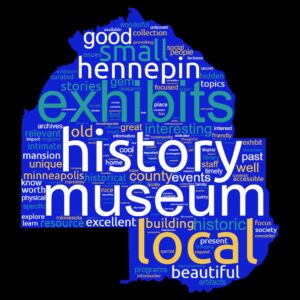
October 3, 2023
Beginning in 2022, Hennepin History Museum conducted a strategic planning process to direct the work of the Museum for 2023-2026. That process is now complete, and in a series of articles in our monthly e-newsletter to members and friends, we are introducing our revised mission statement, as well as vision, guiding principles and strategic goals. Each month, the latest article will be added to this blog to allow anyone to pick up the information at any point in time. We encourage people to join the conversation as this work unfolds. Send your comments and input to: strategy@hennepinhistory.org
History unites communities
when everyone is represented.
Over the past year, the Museum conducted a strategic planning process to chart a path towards organizational growth and increased relevance. The work was based on research, assessment of our strengths and weaknesses, and input from Museum members, staff, community partners, and constituency groups (note: member feedback is highlighted in the Word Cloud above).
In recent years, the Museum’s programming has been shaped by our belief that history has a relevant and powerful impact on how we navigate today’s world. Feedback from all quarters affirmed this direction. With that in mind, the Museum’s Board of Directors approved a new mission and vision statement, both of which we are revealing today, and new guiding principles and strategic goals that we will share in the months to come.
Our mission: We preserve and explore history, creating spaces where our communities’ stories can be told.
We reframed our previous mission to include the how and why we preserve and explore history. And it should be noted that we will continue to engage in this work with others all around the region, inside and outside the history field. Our new mission statement was inspired by an expansive and inclusive vision:
Our vision: History unites communities when everyone is represented.
These seven words reveal the impact Hennepin History Museum and the practice of history can have. Implied here is that we cannot do the work alone, but as part of the network of public history institutions, in partnership with other groups and individuals.
October 6, 2023
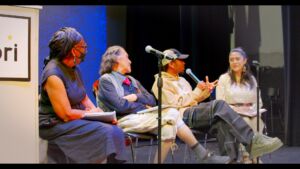
Panelists speaking at the “Evening of Real-life Stories About Social Justice in Minneapolis,” hosted on September 14, 2023, in partnership between the Minneapolis Interview Project and Hennepin History Museum.
Guiding principles to keep us on track.
These are the new three guiding principles that will direct the day-to-day work of the museum over the next few years:
- Promote a new perception of history and history museums.
- Engage people where they are.
- Embrace a collaboration mindset built on mutual trust.
In the past month, the museum hosted two events that received coverage in the local media. While not unique in terms of the kinds of initiatives the museum undertakes, they are great examples of our new guiding principles in action:
- In partnership with the Major Taylor Bicycling Club of Minnesota, we hosted a commemorative bike ride to posthumously honor William “Bill” Dooley, Jr., a tireless biking advocate who was instrumental in changing the biking infrastructure of the Twin Cities.
- In partnership with the Minneapolis Interview Project (MIP), we hosted an event to celebrate the nearly 100 participants who shared their personal histories of inequality and the struggle for social justice in Minneapolis.
Promoting new perceptions: Reporters from the StarTribune, Minnesota Spokesman Recorder, neighborhood newspapers, KMOJ FM, and Fox 9 News all asked us why the museum is interested in such stories–perhaps not what they expected. We responded the same way each time: we explore the stories of people and events that have shaped the community we share because that is our history. Some of you may have noticed a letter to the editor of the StarTribune this past Saturday challenging us to not ignore the history of the early eras of our community because our history “did not begin 70 years ago.” We appreciated this opportunity to bring our goals and challenges into the public discourse, and to show how we explore the entire span of this region’s history.
Engaging people where they are: We reached out to the community to host the MIP event at the Capri Theatre on West Broadway Avenue; likewise, the tour route for the Dooley commemorative bike ride flowed throughout the city to explore the history of modern bicycling. These are just two recent examples of trying to engage people where they are.
Establishing collaborations based on trust: The museum was honored to be chosen by MIP creator Anne Winkler-Morey to be the permanent home of the MIP interviews and related photos, thereby making them accessible to both current and future generations. Our ongoing relationship with the Major Taylor Club has been built on mutual respect and appreciation for what we can do together.
What’s next?
Next up: our strategic goals through 2026. As always, we appreciate your support and value your input! Comments, suggestions, and questions can be directed to strategy@hennepinhistory.org
November 2, 2023
Our strategic plan is made up of three main goals, followed by more detailed objectives for each.
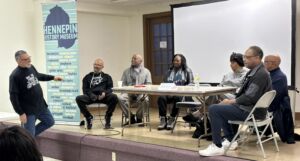
Arthur C. McWatt Fellowship recipient and Hennepin History Museum board of director member Greg McMoore conducting a panel discussion sponsored by Hennepin History Museum of Southside residents entitled “Southside Stories: Our North Star Journey” at St. Peter’s AME Church in Minneapolis in November 2022.
Goal One: Maximize our relevance to a broader audience through programming and place.
Objective: Create welcoming and accessible programming spaces, in our building and around the region.
In our program planning, we usually think of relevance from the content perspective; we pick topics that we think will meaningfully resonate with people. But the relevance question also relates to physical realities—how, where, and when do people engage with us? And that physical question drives directly into one of the museum’s most stubborn problems, namely, the lack of amenities and inefficient use of space in our building.
Our research shows that too often in recent decades, many museums have overbuilt and created longstanding cost burdens for space that does not flexibly meet their needs as they evolve over time. In a rapidly changing world where people increasingly engage online, it makes sense for us to create a functional building that can welcome people in all ways, but also to focus on taking our programs out and about in the region and to offer more digital content.
What does this potentially look like?
- In our building, installing an elevator and modern restrooms are at the top of the list. We are also pursuing ideas to free up space in the building and explore remodeling options, all with an eye to maximizing our public space and flexibility.
- We are actively seeking “homes away from home” that could provide new venues for our programming. For example, if we only need a large auditorium a few times a year, it is better to rent than to buy.
Objective: Leverage the power and potential of digital platforms to reach broader audiences.
There will always be a need for physical gatherings—people need to interact with each other, and one of our best assets are physical objects that draw people in and illustrate stories in a powerful way.
But we can keep pressing the advantage of the digital revolution to reach a broader audience: creating even better research opportunities for access to our knowledge; delivering content on mediums like podcasts to let human voices do their thing; creating videos to give people a visual connection to stories that they otherwise wouldn’t get exposed to.
Objective: Integrate our content across platforms to extend their impact and longevity.
By better integrating our content we can reach more people and also dig deeper into topics of interest. We have some good examples of this that we can build from. Prior to the Human Toll exhibit, an article in Hennepin History gave a preview of the emerging research and was able to introduce oral histories conducted by the team. During the exhibit, programming amplified the stories in the exhibit, and included content that did not fit on the walls. And coming in the fall issue of the magazine, we are introducing new information gleaned from a fresh look in the census records to continue the story. The demand is still high for this history, and we’ll keep looking for creative new ways to deliver it.
Relevance and audience—the two go hand in hand. Now more than ever, we must find ways for history to pull people in with compelling connections to their lived experience. We will work to introduce rich content to people in any number and combination of formats they prefer to “get their history,” whether it is coming to the museum, sitting in an easy chair with our magazine, scanning information from our website on their phone, listening to our podcasts during their day, or taking one of our walking tours. We want to be ready to meet them “where they are.”
December 7, 2023
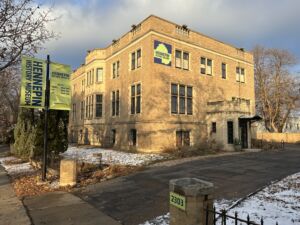
Goal Two: Engage continually stronger operational foundations for the museum.
Objective: Prioritize a new financial reality for the organization, focusing on operating stability and sustainable growth.
The financial challenges faced by non-profit organizations since the pandemic began have been widely reported, and Hennepin History Museum is no exception. But even before then, the museum has often struggled to maintain the level of support necessary for a truly thriving organization. Our board of directors has made a strong commitment to broaden our base of support and manage our existing funds in ways that will help us weather economic downturns and also reinvest in our core infrastructure.
Objective: Transform the role of collections to further our mission and set a course for their sustainable future, relevance, and vitality.
Our museum and archival collections are a key foundation of HHM. We have invested extensive time and resources over the past six years to better understand what we have, and how these collections can serve our communities in the future. While we have many treasured items that tell great stories about our region, we have fallen behind in collecting things that fully represent the breadth and diversity of the current population. The digital revolution also provides opportunity and challenge for our efforts to document life in and around Hennepin County and embracing that will be a key area of focus for the next several years.
Objective: Cultivate long-term organizational partnerships to serve existing and new constituencies.
Our best work usually happens in partnership with individuals and groups, where each party amplifies the strength of the other. Recent examples include our work with the Heritage Studies and Public History graduate program at the University of Minnesota, the local Tibetan community, local artists Daren Hill and Debra George, Valley Community Presbyterian Church, and the Minneapolis Interview Project.
This work is most satisfying and productive when we can go beyond a specific short-term project and find ways to build sustainable collaborations over time. The mutual benefits of these partnerships make each side stronger and the surrounding community richer as a result.
January 5, 2024
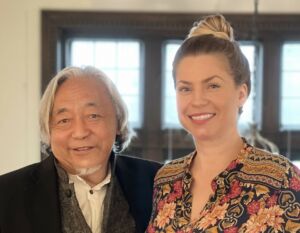
Tibetan American Foundation of Minnesota founder Thupten Dadak with HHM Curator Alyssa Thiede outside our exhibit Faraway Home: Tibetans in Minnesota.
Goal Three: Advance DEAI to transform our institutional identity and heighten a sense of belonging
Objective: Strengthen the board and staff with targeted recruitment, training, and professional development.
Too often, traditional organizations chase diversity but don’t pay attention to their culture to become a truly inclusive, welcoming place that invites the people they recruit to feel like they truly belong. We aim to do the hard work to change that narrative, so that people of varied backgrounds seek us out based on our reputation for being a place where all are equally valued.
Objective: Generate a sense of community relevance and ownership with high impact programs and collections.
Our revised mission statement leads with “preserve and explore history” to replace the traditional “collect, interpret and share” words that were in vogue for so many years. This shift has important ramifications for how we do our work. We intend to be in partnership with communities to preserve our collective heritage rather than narrowly act on our own as collectors. And we will explore history together with people, rather than always being the authority who decides what is important to talk about, and who’s perspective to listen to.
This is easier said than done, but it is an important philosophical change that we embrace.
Objective: Expand our reach by serving the entirety of our region and bringing together communities.
Measured by population, Hennepin County is as large as the next three Minnesota counties combined, and almost a quarter of the statewide total. And since history does not respect political boundaries, the stories we need to explore cover even more territory than that.
That is a big region, a lot of communities—and a lot of untold stories. These stories need to be told—as we’ve learned from the ones we have already explored—because they enhance our ability to live in community together.
We are excited by this challenge and invite others to join us!
